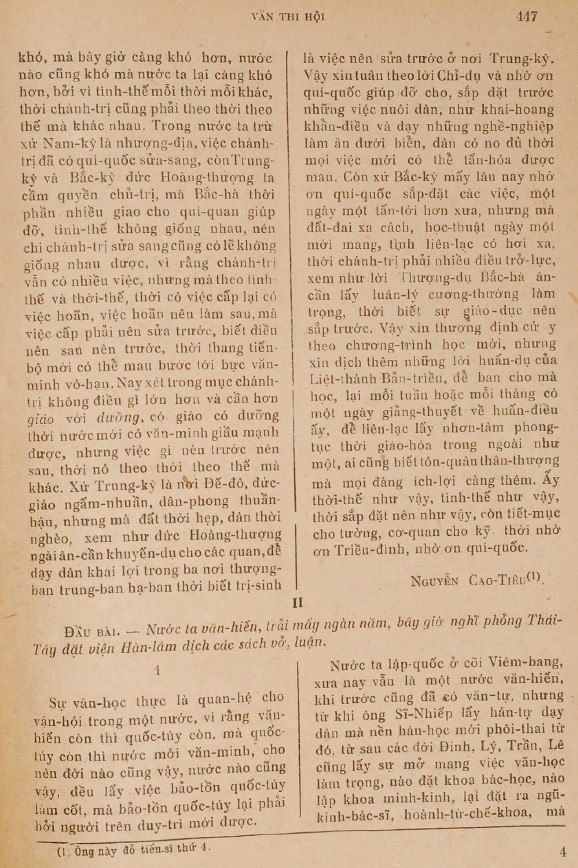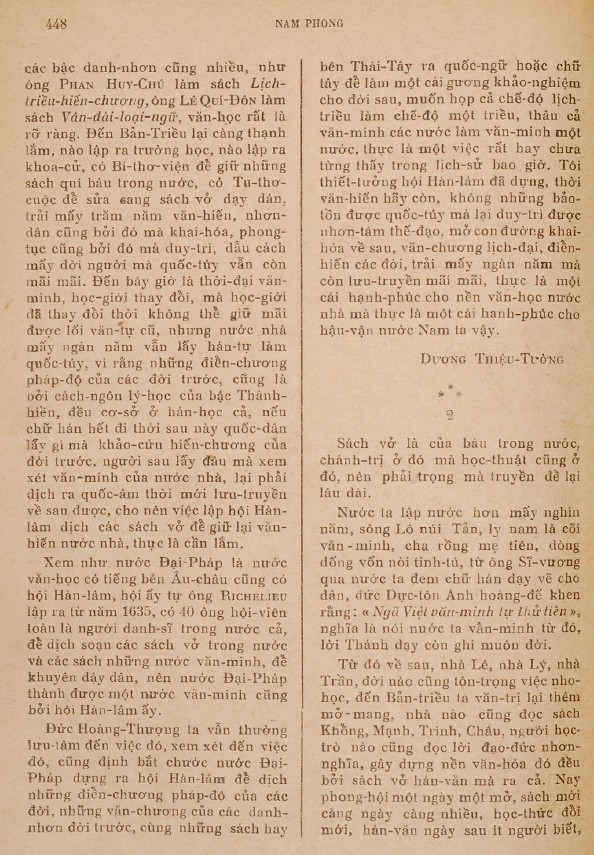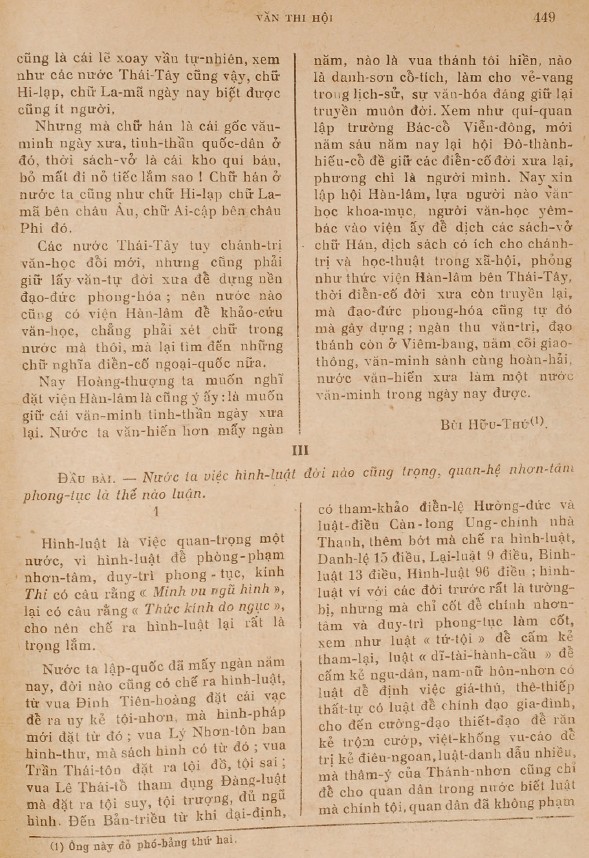When the final palace exam was held in Huế in 1919, there were questions in both classical Chinese and modern Vietnamese (using the Latin script, chữ quốc ngữ). One of the questions in Vietnamese asked the following:
“Our country has been one of literary civility for thousands of years. Should we now follow the Occident and establish a National Academy to translate books? Discuss this.”
And in his discussion of this question, scholar Dương Thiệu Tường said the following:
“The present is an age of civilization and the world of scholarship has changed. And with this change in the world of scholarship it is not possible to maintain the old writing, but for thousands of years the country has taken Hán characters as its national essence [quốc túy]. . .
“If Hán characters disappear then how will the citizens in the future be example to examine the documents from the past? What will later people be able to find to see the civilization of the country? We have to translate [writings in classical Chinese] into the national language as that is the only way that they can be preserved for the future. Therefore establishing an Academy of Sciences to translate books and preserve the literary civility of our country should definitely be done.”

Let’s stop and think about this. In 1919 a scholar at the highest level of the civil service examination system, an institution that was of central importance for traditional education in Vietnam, wrote an answer to a question in vernacular Vietnamese using the Latin script and declared essentially that the world had changed and that the traditional world of Vietnam was not part of that new world.
This has significant implications for our understanding of early twentieth century Vietnam. The way that the history of the early twentieth century has been told (at least in works in English) is that the traditional world essentially lost its legitimacy and its influence in Vietnam with the Nguỹen Dynasty’s inability to resist French conquest and colonialism.
This story goes on then to talk about revolutionaries and reformers who appeared in an effort to accomplish what Nguyễn Dynasty officials had failed to do. Here we learn about Phan Bội Châu and Phan Chu Trinh and the Tonkin Free School (Đông Kinh Nghĩa Thục 東京義塾), but then we also learn that this revolutionary effort to reform Vietnamese society came to an end by 1908-09 as the Tonkin Free School was shut down, Phan Chu Trinh was arrested and Phan Bội Châu was forced to live in exile.
Then for the next decade. . . “not much happens,” and it’s only at the end of the 1910s when Governor-general Albert Sarraut implements some reforms and the French start to set up a school system that includes education in vernacular Vietnamese (using the Latin script) and French, and journals in vernacular Vietnamese start to get published, that “things really started to happen.”
In other words, the history of early twentieth century Vietnam as it is told today is a story about Vietnamese revolutionaries and French colonial officials.
However, those are two very small groups of people. Was their influence really that great? Or are we ignoring what other people did during this period?

What documents from the civil service exams and the world of the Nguyễn Dynasty show, however, is that “a lot” happened in the 1910s. In fact, an entire worldview was transformed.
The change from declaring in classical Chinese in 1910 that the Classic of Changes (Yijing 易經) is the source of all knowledge to arguing in vernacular Vietnamese in 1919 that a National Academy should be established to translate texts from classical Chinese into modern Vietnamese so that future generations will be able to access the national essence of Vietnam – classical Chinese learning. . . that is a massive transformation.
Therefore, I think “the story” of early twentieth century Vietnamese history needs to be reconsidered. Phan Bội Châu did not transform early-twentieth-century Vietnam, nor can Albert Sarraut take credit for what happened in the 1920s.
Instead, the traditional elite transformed themselves, and they also made efforts to transform society, as the writings of Phạm Quang Sán indicate.
What is more, many of those transformations had been underway for a decade before the 1920s began, the time that modern historians regard as a “real time of change” in modern Vietnamese history. Students had already studied the Latin script, and had already learned that the world is round and that there are somewhere around 200 volcanoes on the planet. (see the previous post)

Ultimately the existing story of the history of early-twentieth-century Vietnam takes the form it does because of language and because of certain biases. Phan Bội Châu is important because some of his writings have been translated in to modern Vietnamese and modern Vietnamese historians have highlighted his efforts in their own effort to create a “revolutionary” narrative of modern Vietnamese history.
Albert Sarraut’s reforms and the vibrancy of intellectual life in the 1920s have been the focus of the work of many modern historians as the sources for that period are in modern Vietnamese and French, languages that modern historians have the ability to read.
The evidence for the “great transformation” that I am talking about here, however, is largely in classical Chinese, a language that most modern historians do not read.
As for biases, talking about revolutionaries supports a Vietnamese nationalist view of the past, and discussing French policies has its roots in a Eurocentric approach to Vietnamese history.
Both the Vietnamese nationalist and Eurocentric approaches to the Vietnamese past dismiss the Nguyễn Dynasty as ineffective and unimportant. However, both of those approaches have a motive for dismissing the Nguyễn Dynasty, as doing so enhances their legitimacy.
But what happens if we take the Nguyễn Dynasty world seriously, and if we make the effort to actually read the documents that intellectuals from that world left behind?
I would argue that when we do that, our understanding of early-twentieth-century Vietnam changes. Yes, there were Vietnamese revolutionaries and French officials, but there was an even larger world of “traditional scholars” who transformed into “modern intellectuals” and who sought to get the youth of Vietnam to undergo the same transformation.
And all of this was well under way by the 1920s, the time when “things really started to happen.”

This Post Has 4 Comments
I wish to express my deepest thanks to Pr Kelly for his series of essays on Pham quang San ; I wish for more on PQS and other literati .These essays debunk the narrative which told that the mass of VN literatI and mandarins
apart from Ng truong Tô were stubborn conservatives and deadset against innovation and modernization .That narrative has always chagrined me
Thank you! I need to slow down and get some other things done, but I will try to add more about PQS.
One thing that I discovered that I haven’t written about yet is how connected all of these ideas are (whether pro-reform or anti-reform) to ideas that had been written about a bit earlier in China. It is clear that these people were learning everything from Chinese texts. PGS’s “General Reader” is essentially in early-twentieth-century Mandarin, and my guess would be that much of its content is taken from some text that had already been published in China.
The examples of the ways in which Western learning can be found in the classics are also things that had already been discussed in Chinese writings.
My point here is not to criticize people for “copying everything Chinese,” but to point out that the traditional elite actively tried to learn and figure out what to do, and that they read a lot of Chinese writings, and that there was A LOT of information about the West and Western learning in Chinese writings.
Yes, everyone knows that Phan Boi Chau read some New Writings (Tan Thu), but people don’t really know the extent of the influence in Vietnam of reformist, and anti-reformist, writings from China. But clearly they were VERY influential.
One more comment: one of the things that people don’t recognize is that the Nguyen Dynasty continued to exist and function until 1945. There is this idea that once the Nguyen became a “puppet” of the French, that there is no need to pay attention to it anymore. That’s a mistake.
This is all about the desire for power and influence in 20th century Vietnam. Yes, the people who passed through the Franco-Annamite schools in the 1920s became more Westernized than the Nguyen Dynasty officials were, but they also shared much more than people realize. Nguyen Dynasty officials were no longer thought that people needed to study the classics to understand the world, BUT they did think that the morality that the classics promoted was still good. That is what people like the boys behind the journal Phong Hoa did not like, and that is what made the Nguyen Dynasty elite “outdated.”
I think a version of this same division continued as Vietnam was divided into North and South. In some ways the South was more liberal, but the “modern conservatism” of the Nguyen Dynasty world was kept alive there as well, whereas the North was “revolutionary.”
This strain of “modern conservatism” is something that I don’t think people have examined well yet. People tend to dismiss this group for being “conservative” and don’t pay attention to the way that they were “modern.” But at the end of the day, I think that most Vietnamese in the twentieth were “modern conservatives” rather than “revolutionaries” so understanding that aspect of Vietnamese history is very important.
However, when it comes to creating a narrative for history, it’s always much more exciting to talk about revolutions and revolutionaries.
In any case, this issue of modern conservatism and the continued role of the Nguyen Dynasty is something that I’ve been thinking about for a long time, and have posted about from time to time.
https://leminhkhai.wordpress.com/2014/08/23/the-missing-link-of-modern-conservativism-in-the-du-hoc-bao/
https://leminhkhai.wordpress.com/2013/11/26/missing-voices-in-vietnamese-history/
https://leminhkhai.wordpress.com/2012/04/03/announcements-in-the-indigenous-language-in-colonial-vietnam/
Thanks for the links .
I didn’ t know that concept of modern conservatism .
Your blog is very instructive , one learns frequently of new ideas , new perpectives on past events . You use historian wenyan but it’s intelligible to laymen . You don’t do ex-cathedra teachings , you try new ideas , inviting to discussion and comments . Yours is a most valuable history blog